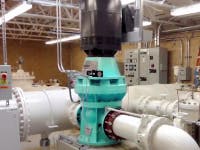The following is a transcript for the WaterWorld Weekly Newscast for May 30, 2017.
Hi, I'm Angela Godwin for WaterWorld magazine, bringing you water and wastewater news headlines for the week of May 30. Coming up...
Recovering energy through hydropower
Calling all water entrepreneurs for the BREW Corporate challenge
WIFIA gets boost in federal funding
LADWP prepares for massive runoff
Moving water is an energy-intensive process, particularly in the west where water is transported over great distances. But it can also generate energy as well.
A process called energy recovery hydropower is able to recapture energy that would otherwise be lost when the pressure of flowing water is reduced by a pressure reduction valve -- prior to entering a treatment plant, for example.
Hydro Group Publisher Marla Barnes spoke with Kurt Johnson, president of the Western Small Hydro Association, to learn more.
KURT JOHNSON: Energy recovery hydropower is simply adding hydropower generation in parallel to a pressure reduction valve and taking mechanical energy which is otherwise being wasted and generating electricity.
The power captured by energy recovery hydropower can help water operators offset the load associated with a water treatment plant.
KURT JOHNSON: Some estimates suggest there are 400,000 or so pressure reduction valves within the existing water distribution system in the United States. Some significant percentage of those can be retrofitted with energy recovery hydropower to both reduce pressure while also generating new baseload clean electricity with virtually zero environmental impact.
On Tuesday, June 27, the Western Small Hydro Association will be organizing an Energy Recovery Hydropower workshop, co-located with the upcoming HydroVision International event in Denver, Colorado.
To learn more, please visit hydroevent.com, click on Co-Located Events, and then select Energy Recovery Hydropower workshop.
The global technology challenge, BREW Corporate, is looking for its next round of promising water entrepreneurs.
The challenge, organized by The Water Council and sponsored by A. O. Smith, aims to identify and support entrepreneurs and start-ups developing innovative freshwater technologies.
Areas of interest include water treatment, water heating, sensors, and the Internet of Things.
Interested parties must complete the online application by June 30.
All entries will be reviewed by a panel of A. O. Smith personnel, The Water Council senior staff, and subject matter experts in the area of freshwater science.
Selected winners will receive a minimum investment of $50,000 from A. O. Smith as well as tuition to participate in The Water Council's 12-month accelerator program in Milwaukee.
To learn more, visit thewatercouncil.com.
In the Consolidated Appropriations Act of 2017, signed into law by President Donald Trump on May 5, the Water Infrastructure Finance and Innovation Act (WIFIA) program received an additional $8 million for credit subsidy.
The additional funding, combined with the $17 million appropriated for credit subsidy in December 2016, will allow the WIFIA program to lend approximately $1.5 billion for water infrastructure projects.
In response to the Notice of Funding Availability issued in January, EPA received 43 letters of interest for WIFIA loans with a collective request of $6 billion.
EPA said the letters demonstrate the high need to invest in water infrastructure improvements and the value that WIFIA financing can offer.
For more information about the WIFIA program, visit epa.gov/wifia.
The Los Angeles Department of Water and Power is anticipating massive runoff water resulting from this year’s near record snowpack in the Eastern Sierra Nevada Mountains -- and efforts are underway to harness it.
The utility is lowering reservoirs to create more storage space for runoff water and is maximizing flows to the City of Los Angeles with aqueduct water in place of purchased water and groundwater wherever possible.
It's also spreading water throughout the aqueduct system to replenish local groundwater aquifers.
Other activities include preparing, cleaning, and repairing water conveyance ditches, spreading basins, sand traps, and other facilities that are controlled by the utility.
Up to 1 million acre feet of water -- or about twice the amount of water Angelenos consume in one year -- is expected to flow through the aqueduct system this spring and summer.
For WaterWorld magazine, I'm Angela Godwin. Thanks for watching.


